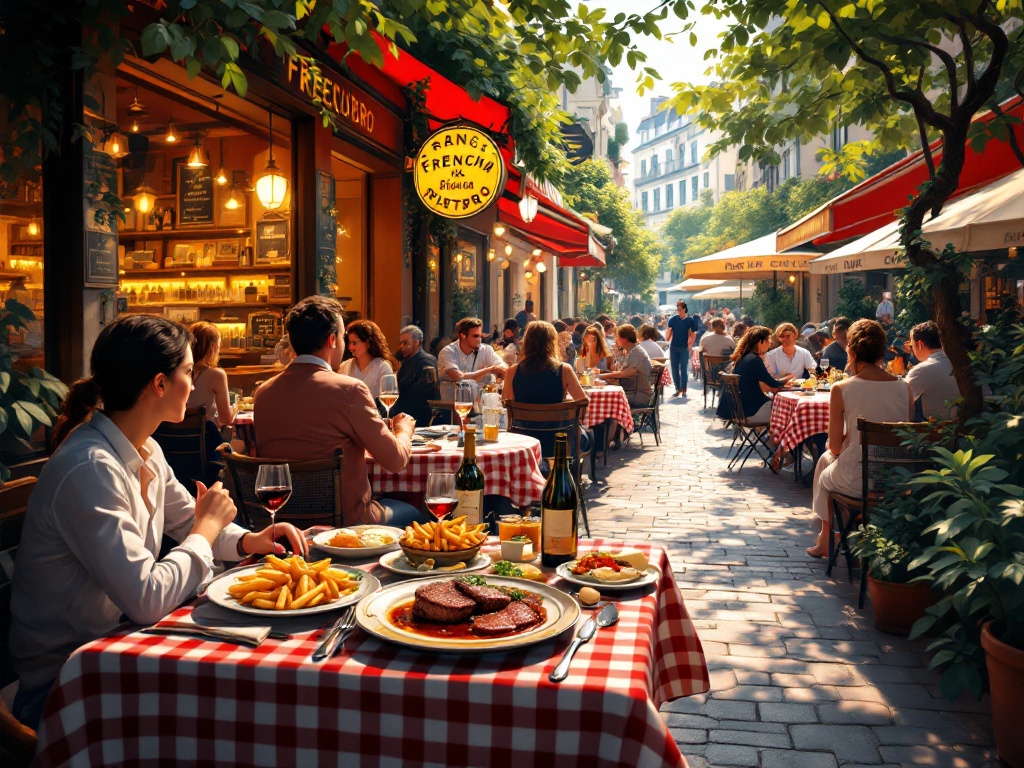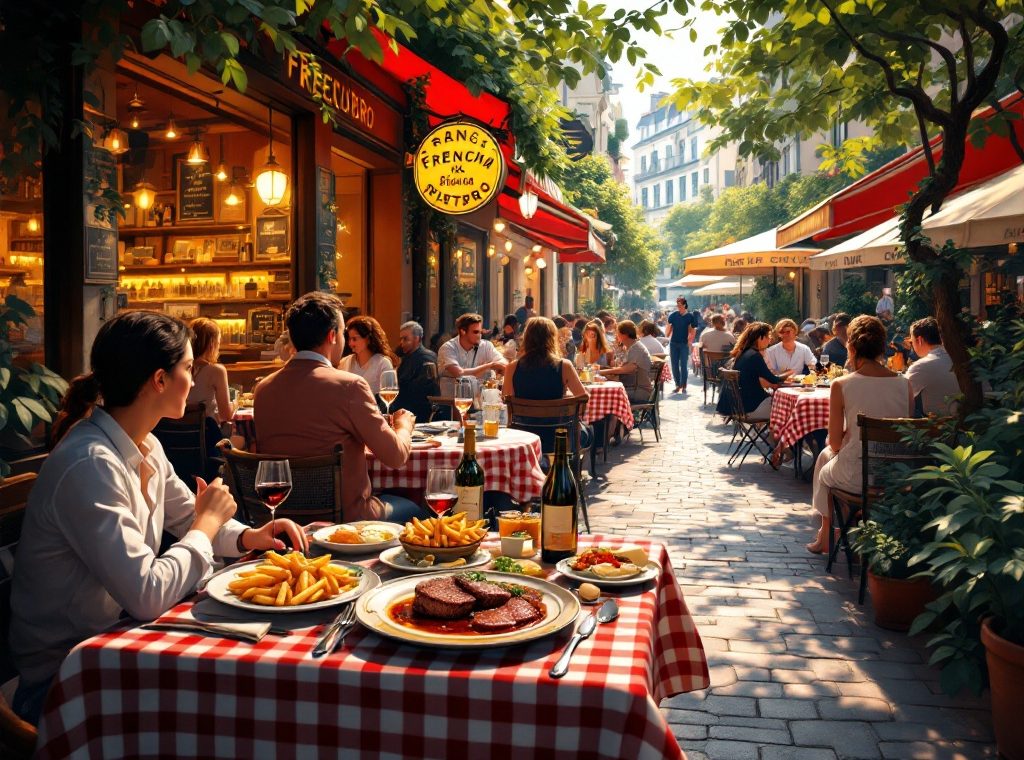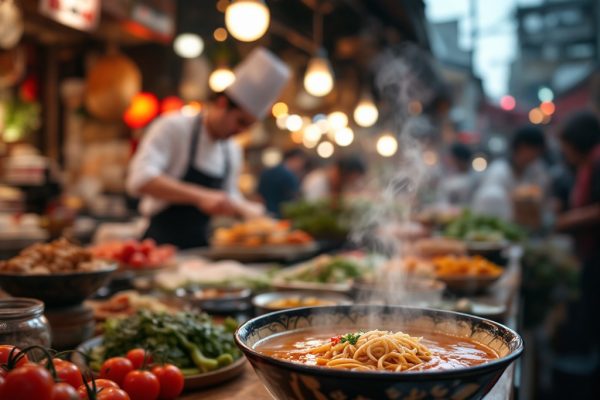Discover France and Its Food Culture
Embark on a culinary adventure through France, where food is not just sustenance but a cherished ritual woven into the fabric of daily life. Discover time-honored traditions, from casual bistros serving steak frites to Michelin-starred restaurants showcasing haute cuisine. Explore regional specialties like hearty cassoulet and flavorful bouillabaisse, each reflecting France’s diverse terroir. Uncover the art of French wine and cheese pairing, and master dining etiquette to fully immerse yourself in this rich culture. Delve into the heart of French gastronomy and savor every moment. Read on to uncover the secrets of French cuisine.
Important information

- French food culture prioritizes fresh, high-quality, seasonal ingredients and diverse regional specialties.
- Meals are a central part of French social life, emphasizing togetherness and the enjoyment of food.
- French cuisine has evolved over centuries, influenced by medieval traditions, Italian techniques, and New World ingredients.
- From casual bistros to Michelin-starred restaurants, French dining offers diverse experiences. Wine pairing and cheese courses are integral parts of the dining experience.
- Dining etiquette in France includes keeping hands visible, placing bread on the tablecloth, and waiting for the host to begin eating. A service charge is usually included, but rounding up or leaving a small extra amount is customary for good service.
Discover France and Its Food Culture
French food culture thrives on fresh, high-quality ingredients and embraces regional diversity and time-honored culinary traditions. Meals are deeply woven into the fabric of French social life and national identity. They are cherished occasions emphasizing the pleasure of food and togetherness. Whether enjoyed in a casual bistro or a Michelin-starred restaurant, dining in France is a cultural experience. The country is renowned for its incredible cheeses, wines, and pastries. Each reflects regional flavors and a rich history. From classic dishes like Cassoulet and Boeuf Bourguignon, the French proudly celebrate a culinary heritage that represents the heart of their cuisine.
The Importance of Mealtime in French Culture
In France, meals are more than sustenance; they’re a cornerstone of daily life and a time for family and connection. The French reverence for mealtimes reflects their appreciation for both food and shared experiences. Savoring food together strengthens social bonds and fosters a sense of community. The prevalence of long, leisurely meals underscores the French emphasis on work-life balance and prioritizing time with loved ones. These gatherings go beyond mere nourishment; they’re a celebration of French culinary heritage and the profound cultural significance of food in France. It’s a way of life.
Why Mealtime is Practically Sacred
In France, meals are more than just sustenance; they are a cherished ritual, a time to pause and connect. This shared experience is deeply ingrained in French culture, elevating dining to an art form. The French savor these moments, bonding with others and appreciating the simple act of sharing a meal. This tradition transforms mealtimes into something truly special.
Mealtime: A Reflection of French Work-Life Balance
The French prioritize shared meals, reflecting their commitment to work-life balance. Unlike cultures where meals are rushed, the French enjoy leisurely mealtimes, savoring both the food and the company.
These extended meals are integral to French social life, strengthening community ties. This cultural emphasis on communal dining is evident everywhere, from family dinners to business lunches. It underscores their appreciation for slowing down and enjoying life’s simple pleasures.
The Role of Community in French Mealtime
In France, meals are more than just sustenance; they are treasured social events. Families and friends unite to share food, strengthening bonds and creating a sense of community. This ingrained cultural practice offers a space for conversation, laughter, and shared experiences, highlighting how food brings people together. This tradition emphasizes the importance of togetherness and the simple pleasure of a shared meal.
French Culinary Traditions and Techniques
French cuisine, known for its rich flavors and intricate techniques, has a history rooted in the Middle Ages. Italian culinary traditions significantly influenced its evolution, further enriched by the discovery of New World ingredients. This blend of diverse influences shaped the French cuisine we savor today.
The Evolution of French Cuisine from the Medieval Era
French cuisine originated in the lavish feasts of medieval nobility. These elaborate meals not only provided enjoyment but also shaped early culinary practices and established traditions that have endured for centuries. Imagine grand banquets with overflowing tables—this opulent setting is where French cuisine began its rich history.
Influence of Italian Technique and New World Exploration
French cuisine was significantly influenced by Italian culinary techniques during the Renaissance, which were enthusiastically adopted by French chefs. The discovery of the New World further expanded French cuisine’s flavors and possibilities with exciting ingredients like tomatoes, potatoes, corn, and beans.
Layered Flavors and Mastery of Technique in French Cooking
French cooking is a delicate art of building flavor layer upon layer, resulting in a richly satisfying experience. Refined techniques contribute to this depth, but the true emphasis lies not in elaborate presentation, but in the exquisite taste. Balance is key, evident in iconic dishes like the humble yet flavorful onion soup or a perfectly seared steak enhanced by a subtle pan sauce. Ultimately, French cuisine celebrates the essence of each ingredient, prioritizing quality over complexity.
Typical French Dishes and Regional Specialties
French cuisine offers a captivating journey for the palate, boasting both iconic dishes and diverse regional specialties. From the hearty cassoulet, a slow-cooked southwestern bean and meat stew, to the rich red wine braise of Burgundy’s boeuf bourguignon, the country offers a symphony of flavors. Chicken braised in wine, coq au vin, is another beloved classic. The vibrant ratatouille, a Provençal vegetable stew, and the comforting warmth of French onion soup, or soupe à l’oignon gratinée, are also French staples.
Regional Delights
Beyond the iconic dishes, French cuisine’s true richness lies in its regional diversity.
- Coastal Brittany: Known for delicate crêpes and savory buckwheat galettes.
- Alsace: Offers choucroute garnie, a hearty sauerkraut and sausage dish, reflecting German influences.
- Provence: Home to bouillabaisse, a flavorful fish stew, and aïoli, a rich garlic mayonnaise.
Emphasis on Freshness
At the heart of French cuisine is a deep respect for fresh, seasonal ingredients. Local markets overflow with vibrant produce, shaping dishes and maximizing flavor. This emphasis on seasonality reflects a strong connection to the land and its bounty.
Signature Dishes: Cassoulet, Boeuf Bourguignon, and More
Cassoulet, a rich, slow-cooked casserole from southwest France, features meats like pork sausage, goose, duck, and sometimes mutton, all simmered with hearty white beans. Boeuf Bourguignon is another classic French comfort food. It consists of beef braised in red wine with onions, mushrooms, and bacon.
Similarly, Coq au Vin features chicken braised in wine. Moving beyond meats, Ratatouille, a vibrant vegetable stew, and Bouillabaisse, a flavorful fish stew, further showcase French culinary expertise. These dishes highlight regional ingredients and unique cooking techniques. French cuisine also boasts pastries like croissants and macarons, and iconic cheeses like Camembert and Roquefort.
Regional Delicacies: From Brittany to Provence
France’s culinary tapestry is rich and varied. Brittany is renowned for its crêpes and savory buckwheat galettes. Provence delights with dishes like bouillabaisse and ratatouille, infused with herbs, olive oil, and fresh seafood. Normandy offers rich dairy products and seafood, while Alsace is known for its choucroute. In Southwest France, the hearty cassoulet takes center stage.
The Influence of Fresh and Seasonal Ingredients
French cuisine prioritizes fresh, seasonal ingredients to enhance flavor and nutritional value while supporting local agriculture. Menus evolve with the seasons, offering a vibrant culinary journey. Savor spring asparagus or juicy summer tomatoes—each season brings unique delights.
The Art of French Wine and Cheese
Wine is an integral part of French dining, elevating the experience and reflecting the country’s culinary identity. Each region boasts unique wines that complement local cuisine. Cheese, another essential element, typically follows the main course. The French artfully pair wines with dishes to enhance their flavors, a tradition deeply embedded in their culture.
Understanding French Wine Culture
French wine culture and cuisine are deeply intertwined, with each enriching the other. In France, wine is more than just a beverage; it’s a fundamental element of the dining experience. The country’s diverse terroir, showcased in regions like Bordeaux and Burgundy, yields an impressive variety of wines perfectly matched to specific dishes. For example, a robust Bordeaux beautifully complements a rich steak. This practice of thoughtful pairing reflects France’s rich culinary heritage and elevates dining to an art form. The French have truly mastered this delicate balance, making it a cornerstone of their culture.
Les Huit Familles de Fromage: The Cheese Plate Tradition
“Les Huit Familles de Fromage,” or “The Eight Families of Cheese,” is a French tradition of categorizing cheeses by their production methods and textures. These eight families offer a vast spectrum of flavors and textures, making a cheese plate featuring one from each a delightful culinary adventure. The eight families include: fresh, soft-ripened, washed-rind, pressed (cooked and uncooked), blue, goat, and processed cheeses. Imagine savoring a fresh chèvre alongside a creamy Camembert and a pungent Roquefort—each a distinct representative of its family, boasting a unique taste. Exploring these families deepens your understanding and appreciation of the remarkable diversity found in French cheeses.
Exploring French Dining Venues
Cafés are integral to French culture, serving as vibrant social hubs where people gather for coffee, quick bites, and conversation. Patrons socialize, read, or simply relax while enjoying offerings like pastries, sandwiches, and light meals.
Bistros provide a casual dining experience, featuring generous portions of affordable, home-style dishes. Classics like steak frites, onion soup, and coq au vin showcase their focus on simple yet flavorful food in a relaxed setting.
Brasseries offer a more formal ambiance, often with elaborate decor and extensive menus featuring seafood, regional specialties, and large platters like choucroute garnie, a hearty dish of sauerkraut and assorted meats. Unlike bistros, brasseries typically operate all day, serving breakfast, lunch, and dinner.
From casual eateries to Michelin-starred establishments, French restaurants cater to a diverse range of budgets and preferences. Some specialize in regional cuisine, while others offer international flavors or haute cuisine—the pinnacle of French gastronomy, emphasizing artistic presentation, meticulous preparation, and innovative techniques.
The Role of Cafés in Everyday French Life
French cafés are more than just places to grab a coffee, they’re woven into the fabric of daily life. They serve as vibrant social hubs where people relax, connect with friends, and enjoy simple meals and drinks. Cafés also offer a tranquil escape for those who want to read or simply observe the world go by. This integral role in French culture makes them truly special.
Bistros: Hearty Portions of Comforting French Food
Bistros are casual French restaurants known for their relaxed atmosphere and affordable prices. They offer a taste of classic French cuisine without breaking the bank. Some iconic bistro dishes include Steak Frites (steak and fries), comforting French onion soup, and the ever-popular Croque Monsieur.
Brasseries: Known for Large Platters of Choucroute
Experience the vibrant energy of a traditional brasserie, where generous platters of choucroute are a celebrated specialty.
Restaurants: From Casual to Haute Cuisine
French dining offers a remarkable spectrum of experiences, from the inviting ambiance of cozy bistros to the refined elegance of Michelin-starred restaurants. Casual bistros are perfect for a relaxed meal, featuring simple menus and efficient service. In contrast, haute cuisine establishments present an elaborate, multicourse journey where artistic presentation transforms each dish into a culinary masterpiece.
Bistros
Enjoy a relaxed, casual dining experience with simple menus and quick service.
Haute Cuisine
Experience an elaborate, multicourse meal with artistic presentation and refined flavors.
Many French restaurants also specialize in regional cuisine, inviting diners to explore a diverse tapestry of local flavors. Brittany’s coastal eateries highlight the freshest seafood, while Alsace offers the hearty choucroute garnie.
Dining and Tipping Etiquette in France
French dining is more than just a meal; it’s a social experience with unique customs. For example, keep your hands visible above the table and place bread directly on the tablecloth. Wait for your host to begin before you start eating. Don’t cut your salad; fold it with your fork and knife. Cheese is served after the main course but before dessert, a crucial element of the French meal.
French Dining Etiquette
- Keep your hands visible above the table.
- Place bread directly on the tablecloth.
- Wait for your host to start eating.
- Fold your salad with your fork and knife, don’t cut it.
- Cheese is served after the main course, but before dessert.
Tipping in France
A service charge (service compris) is included in the bill, so additional tipping isn’t mandatory. However, rounding up the bill or leaving a few extra euros for exceptional service is a thoughtful gesture. You can leave the tip on the table or hand it directly to your server.
Proper Dining Etiquette for a French Meal
Keep your hands visible above the table, not in your lap.
Place bread directly on the tablecloth; no side plate is needed.
Cut cheese with a knife, not a fork.
To signal you’re finished eating, place your knife and fork side by side on your plate at the 5:25 position.
Place your bread on the tablecloth above your plate to indicate you are done.
Navigating Tipping Etiquette in French Restaurants
French restaurants usually include a service charge (service compris), which covers the tip. However, rounding up the bill or leaving a few extra euros is a polite way to show appreciation for exceptional service.
The French Gastronomic Experience
French gastronomy is more than just a meal; it’s a cultural experience, a celebration of heritage expressed through elaborate meals and elegant dining. Using fresh, high-quality ingredients and traditional techniques, regional specialties shine. French cuisine tells a story of the country’s history, geography, and social customs. Dining in France is a cherished ritual and art form, vital to their national identity.
Multicourse Meals and Fine Dining
French fine dining is an art form, a leisurely multi-course exploration of exquisite flavors. Rather than rushed, these meals emphasize high-quality ingredients and meticulous preparation. From appetizer to dessert, each course presents a unique symphony of textures and tastes. This structured approach showcases the chef’s culinary creativity and skill. More than just a meal, French fine dining is a cultural experience celebrating French culinary heritage.
Food as a Cultural Exploration
French cuisine is deeply intertwined with the nation’s heritage. Sharing meals fosters a sense of community and strengthens social connections. The diverse regional cuisines, showcasing local ingredients and time-honored cooking methods, contribute to France’s renowned gastronomy. From Parisian bistros to the vineyards of Bordeaux, exploring French food offers a unique cultural experience. In France, food transcends mere sustenance; it’s a celebration of life, an homage to tradition, and a reminder to savor every moment.
Celebrating French Culinary Heritage
French culinary heritage thrives on tradition, valuing classic techniques and regional specialties. Fresh, high-quality ingredients are essential to this culinary tradition.
French dining is more than just nourishment; it’s a social experience, a time for family and friends to connect. Moreover, French cuisine is an art form, reflecting France’s rich history, diverse geography, and unique social customs.













